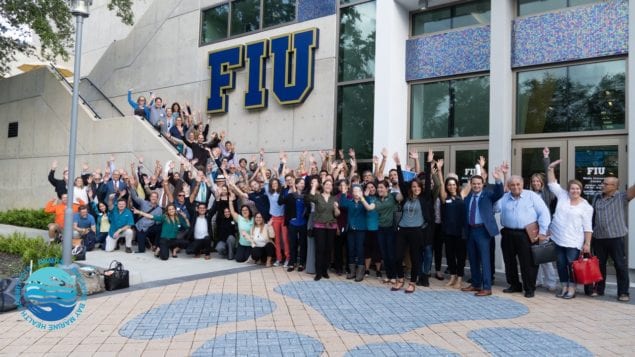After two solid years of meetings and planning, the 2019 Biscayne Bay Marine Health Summit opened the floodgates to ideas — and solutions — that will help eliminate harmful marine debris and pollutants in Biscayne Bay. “The Action Summit” took place Sept. 20 at the Florida International University Biscayne Bay Campus, 3000 NE 151 St. in North Miami.
This second iteration of the initial summit held in 2017 promised to “build solutions through collaboration, education, and innovation,” while providing a greater and more aggressive vision. After all, Biscayne Bay and its adjoining waters, providing $6 billion in annual revenue to the local economy, are among Miami-Dade’s most outstanding natural resources.
This year’s summit also included as a special guest State Attorney Katherine Fernandez-Rundle who gave an update on the recently released “Grand Jury Report on the Health of Biscayne Bay.”
It was two years ago that the inaugural Biscayne Bay Marine Health Summit took place, organized by 50 local concerned Biscayne Bay lovers and activists, representing environmental NGOs, government entities, private businesses, and educational institutions.
Focused on initiating discussions regarding the ongoing challenges Bay was experiencing, that initial effort was a resounding success, with close to300 attendees. One of the significant achievements of that first meeting was creation of a comprehensive report titled,
“The 2017 BBMH Summit Proceedings.”
With the 2019 summit, they came together again to implement this second summit to initiate efforts towards the creation of longterm, sustainable Biscayne Bay environmental health initiatives with financial and political support needed to restore and maintain the health of the bay.
At the “headwaters” of the problems facing Biscayne Bay is the tremendous population growth Miami-Dade has experienced during recent decades, driven by the presence of a staggering amount of marine debris. Government agencies, community organizations, and thousands of community volunteers have for years organized cleanups of the bay’s shoreline to remove debris and litter from its delicate ecosystem. However, these efforts are not enough.
The wide-ranging outcomes of the 2019 “Action Summit” centered around: Identifying, advocating for, and recommending best management practices; putting forth solutions for research and technology, and forming policy recommendations for the Miami-Dade County Biscayne Bay Task Force.
The summit also aimed to include representatives from all Miami-Dade County municipalities surrounding Biscayne Bay, including inland communities along canals and Miami River, environmental NGOs, businesses and educational institutions, amongst many others.
Biscayne Bay and its adjoining waters are among Miami-Dade’s most outstanding natural resources. Shallow, clear water, seagrass meadows and coastal wetlands provide habitat and nurseries for key fish species and wildlife, buffer the coast against storm erosion, support boating and water-related recreational activities, and provide over $6 billion annual revenue to the local economy. Most of Biscayne Bay is designated as a State Aquatic Preserve or is part of Biscayne National Park, and is intended to be preserved for future generations as a public, shared natural resource.
For information, contact Luiz Rodrigues at 786-853-1855 or at BiscayneBaySummit@gmail.com. Also visit the Summit’s landing page at https://soptechint.com/biscayne-bay-marine-health-summit.








